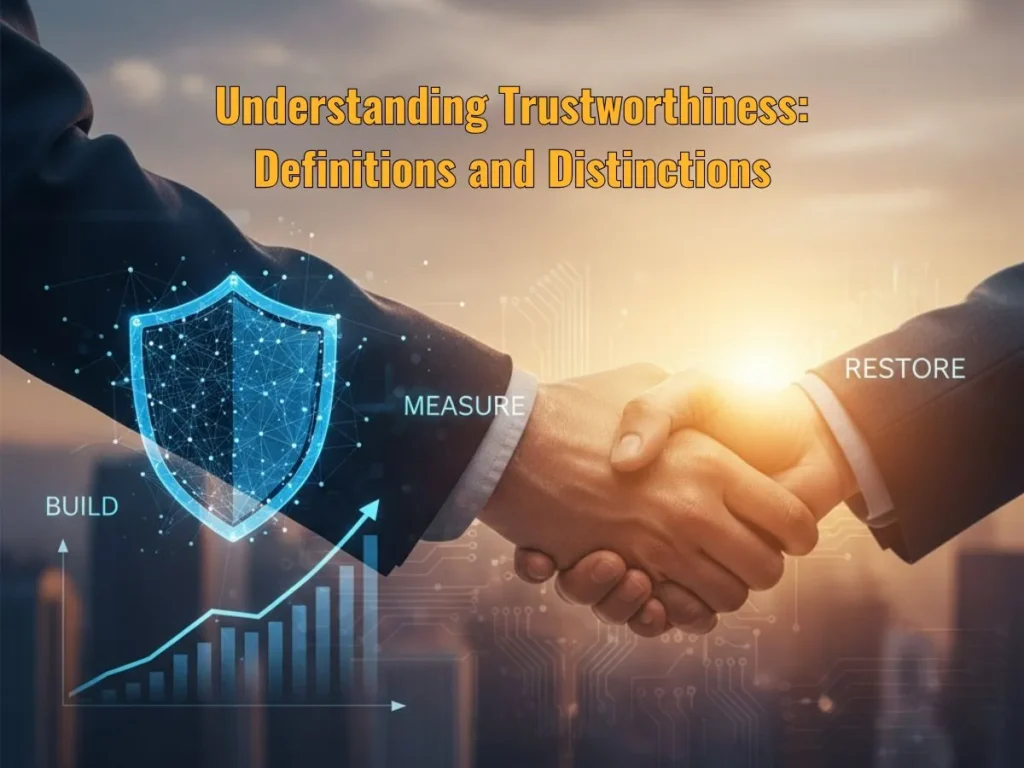Trustworthiness is critical; A crash last year at a major bank took hundreds of millions of pounds out of thousands of customers’ accounts for weeks, showing why.
The financial loss to the bank was substantial, but more severe was the devastating impact on its reputation, as it lost the trust of its customers.
In the digital age of constant data breaches and faceless interactions, trust is harder than ever to earn and easier than ever to lose.
Simply being trustworthy is no longer enough; you must show up and prove that you can be trusted.
In this guide, the author provides a pragmatic pathway to elevating trustworthy for yourself, through how to create it, measure it, and restore it if broken in your personal and professional life.
Understanding Trustworthiness: Definitions and Distinctions

To work with trustworthiness, you need to be able to define it. It is more than just a feeling; it’s a calculated assessment of risk that draws on character and competence.
For instance, many mix it up with similar ideas, but the differences are vital.
Trust vs. Credibility: The Crucial Difference
Trust and credibility are often used interchangeably by people. They do work on different planes, though.
- Credibility has to do with your past. It is based on your expertise, the track record you have built, and the achievements you have proven yourself capable of. A surgeon with an excellent track record is credible. The platitude goes that a company with a longstanding history of positive financial reports is reliable. Credibility is the answer to the question, “Can you do the job?”
- Trustworthiness is about your future. It’s based on your character and integrity, and it also hinges on what others believe is your intent. It’s a question of trust: will you be true to your word, and can I depend on you, not only appearance-wise but when others aren’t around? Reliability answers the question: “Will you personally tend to be truthful?”
You can be credible without being honest (a brilliant but dishonest general). But you can’t be actually trustworthy if you’re not plausible in the space.
The Four Pillars of Trust
To illustrate this idea more clearly, business author Charles H. Green created the “Trust Equation,” which is a potent model.
This equation factors trustworthiness into four main components:
- Credibility: Do You Have What It Takes?
- Reliability: Are you reliable and consistent?
- Intimacy: Safe people to tell your secrets do they trust you? (This refers to emotional safety.)
- Self-Orientation: How self-centered do you think you are?
Therefore, a high focus on self-interest (high Self-Orientation) is the single biggest trust-killer, undermining all other positive traits.
Why Being Trustworthy Isn’t Enough
It won’t be helpful to have these qualities without saying anything. In a digital, noisy world, perception is just as important as fact when it comes to trust.
You really have to proactively and consistently show how trustworthy, truthful, and good you are. Your actions must be visible.
Your communication must be transparent, and values must be clear. This is where the hard work of building trust begins.
The Three Pillars of Building Trustworthiness
Real trustworthy is a dynamic and intentional undertaking. It is based on three fundamental values, which are relevant to the individual, leaders, and even the entire brand.
Pillar 1: Consistency and Trust
Trust is built upon reliability. People believe what they can foresee. When your behavior is predictable, people don’t squander time trying to discern your motivations.
The key to sustainability is accountability. This means:
- Under-promise and over-deliver.
- Adopt and adhere to explicit organizational values.
- Take responsibility for your mistakes without deflecting blame.
When you are reliably accountable, you attract trust as a reliable force of nature.
Pillar 2: Honesty and Transparency for Trust
Honesty is telling the truth. Transparency is providing others with the context and information they need to understand what’s really going on.
As a result, all stakeholders, whether employees, customers, or family members, demand transparency today.
This means:
- Be open about mistakes.
- Communicate changes proactively.
You should be open about if you or a product is running late, a mistake has been made. This open communication means you don’t make anyone feel lied to, which can be even worse than the act itself.
Pillar 3: Competence and Expertise (The E-E-A-T Connection)
You might be the most honest and trustworthy person in the universe. But if you don’t get results, people won’t trust you with high-stakes stuff. This is why competence matters.
In digital, Google crystallizes this idea into E-A-T (Expertise, Authoritativeness, and Trustworthiness). For trust to be established in the digital age, we need your brand to show up as an authentic authority.
You can do this by creating:
- High-quality content.
- Expert reviews.
- A strong point- or project-based evidence of working professionally (or professionally-like).
Competence shows that you’re not only well-meaning but also competent.
Measuring and Auditing Organizational Trustworthiness
“You can’t manage what you can’t measure.” This means that businesses need to measure trust with the same precision as they do revenue. This also adds to building a good public image.
Quantitative Measures of Trust
Trust is something you can measure with real numbers and indicators. Key indicators include:
- Net Promoter Score (NPS): A great proxy for trust, asking customers how likely they are to refer you.
- Customer Lifetime Value (CLV): Long-term customers who trust your business are more likely to remain and spend more. A high CLV usually signals a lot of trust.
- Retention of Employees: High attrition, particularly among high performers, suggests a lack of trust within the organization.
- Public Review Scores: Platforms are a direct window into the PC of your brand.
Qualitative Audits for Institutional Trust
Numbers don’t make up the entire landscape. Institutional reliability also needs a qualitative investigation. For instance, industries such as healthcare are emphasizing community trust and health justice.
Methods to gain insights include:
- Stakeholder Interviews: Conduct interviews with your customers and employees. Inquire where they believe the organization stands up to its values.
- Safety Culture Audits: Determine if management practices what they preach. Is there psychological safety?
Mapping Your Trust Gaps
Aggregate your data to form a “trust map.” This exercise helps you to hone in on just where trust falls apart. Or is it a gimmick that doesn’t live up to marketing hype?
A system of customer service that seems inherently unfair? The first step to fill these particular gaps is recognizing them.
Restoring Trust: The Roadmap to Rebuilding Trustworthiness
Trust is fragile. Once it’s broken, it can seem impossible to fix. But with an intentional, genuine approach, faith can be restored. This map is essential for anyone seeking to regain trust after lying.
The Critical First Step: The Honest Apology
A genuine apology is the indispensable first step. N.B. A feeble or defensive apology will make things worse.
An effective apology has three parts:
- Admit the Harm: You must acknowledge what you did that was wrong, specifically stating the pain you caused.
- Full Responsibility: Stand in full OWNERSHIP of the action and its ramifications. Do not use blaming language.
- State the Plan for Change: Inform them of the future changes, outlining a Plan to Prevent Recurrence.
Step 2: Proving New Trustworthiness Through Action
Words are meaningless without follow-through. Trust must be regained when trust has been broken; you earn that back by demonstrating a new pattern of behavior, showing that you are now reliable. This process takes time. You have to take the heat.
- Make new, visible commitments.
- Stick to them without fail.
So that we can work on building trust up over the long term. Because it hasn’t been there for a while.”
When to Cut Your Losses and Move On
Not all trust is or should be restored. In instances of deep betrayal, such as fraud or repeated intentional harm, the breach may not be redeemable.
Knowing when to salvage a relationship is self-preservation at its best. The most reliable course of action can be to leave.
Trustworthiness in the Digital Age: AI and Future Trust

Technology is redefining what we consider to be trustworthy. But, as we turn these decisions increasingly over to algorithms and AI systems, it’s not the same.
Building Trust in AI Systems
How can we trust a decision taken by a machine we do not understand? The question at the heart of ethical computing is this one.
Building trust in AI requires:
- Transparency & Explainability: The system’s decision should be easy to understand. We need to understand the reasoning behind an AI model’s decision to make a recommendation.
- Reducing bias: AI models trained on biased data exhibit biased behavior. Fairness is critical to the public legitimacy of these systems.
- Data Integrity: The reliability and privacy of AI’s underlying data is bedrock. Without trusted data, the whole system is suspect.
The Future of Trustworthiness: Accountability and Oversight
As digitalisation gains momentum, so does the demand for accountability. It is no longer acceptable for consumers to be told “it’s the algorithm.”
An apparent oversight in holding organizations accountable for the actions of their technological systems will characterize future digital trust.
Conclusion:
Trustworthiness is no mere soft skill; it’s the essential coin of the modern relationship and transaction, the invisible engine that powers loyalty, collaboration, and brand equity.
To succeed, the path is clear: first, build this currency with unwavering consistency and radical honesty. Second, measure its strength using both complex data and essential human feedback.
And finally, restore it, when necessary, with sincere apologies and a new record of proven action.
Begin by picking one area a relationship, project or interaction where youll deliberately be more transparent, reliable or responsible starting today.
FAQs
What is the difference between trustworthiness and credibility?
Trustworthiness is about what you, as a person, are like and what your motives are; credibility is about how capable you are and who has believed in you before.
What are the four pillars of trustworthiness?
The four pillars are Credibility, Reliability, Intimacy, and very little Self-Orientation (Maister’s Trust Equation).
How can I measure institutional trustworthiness?
You can track it using both quantitative metrics, such as NPS, CLV, and employee retention rates, and qualitative culture audits.
What is the most crucial step in restoring broken trust?
The next best thing is to issue a heartfelt, no-excuses apology, accepting full responsibility for the wrongs committed.
How does E-E-A-T relate to trustworthiness?
E-A-T (Expertise, Experience, Authority, and Trustworthiness) is Google’s approach to understanding digital trust and website quality.




